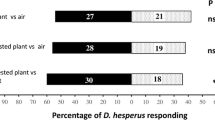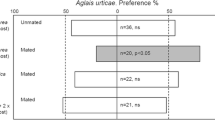Abstract
When experienced by contact with feces from hosts feeding on cowpeas, laboratory-reared females ofMicroplitis croceipes, a larval parasitoid ofHeliothis spp., orient and fly to odors of the same feces, whereas naive laboratory-reared females do not. Flight-tunnel studies revealed that associative learning occurs during female encounters with hosts and host products. When females antennate host feces, they learn to recognize the volatile odors associated with the feces. Females even can be conditioned to respond to novel and otherwise unattractive odors such as vanilla extract by exposure to these volatile substances in association with a water extract of the feces. They apparently link the volatile odors with a nonvolatile hostspecific recognition chemical found in the feces. The antennating stimulant, 13-methylhentriacontane, was found to be a valuable ingredient, apparently as a facilitator of the initial antennation and subsequent linkage of the volatiles to the nonvolatile host recognition cue.
Similar content being viewed by others
References
Ding, D., Swedenborg, P.D., andJones, R.L. 1989. Plant odor preferences and learning inMacrocentrus grandii (Hymenoptera: Braconidae), a larval parasitoid of the European corn borer, Ostrinia nubilalis (Lepidoptera: Pyralidae).J. Kans. Entomol. Soc. 2:164–176.
Drost, Y.C., Lewis, W.J., Zanen, P.O., andKeller, M.A. 1986. Beneficial arthropod behavior mediated by airborne semiochemicals. I. Flight behavior and influence of preflight handling ofMicroplitis croceipes (Cresson).J. Chem. Ecol. 12:1247–1262.
Drost, Y.C., Lewis, W.J., andTumlinson, J.H. 1988. Beneficial arthropod behavior mediated by airborne semiochemicals. V. Influence of rearing method, host plant, and adult experience on host-searching behavior ofMicroplitis croceipes (Cresson), a larval parasitoid of Heliothis.J. Chem. Ecol. 14:1607–1616.
Eller, F.J., Tumlinson, J.H., andLewis, W.J. 1988. Beneficial arthropod behavior mediated by airborne semiochemicals: Source of volatiles mediating the host-location flight behavior ofMicroplitis croceipes (Cresson) (Hymenoptera: Braconidae), a parasitoid of Heliothis zea (Boddie) (Lepidoptera: Noctuidae).Environ. Entomol. 17:745–753.
Gross, H.R., Jr., Lewis, W.J., Jones, R.L., andNordlund, D.A. 1975. Kairomones and their use for management of entomophagous insects. III. Stimulation of Trichogramma achaeae, T. pretiosum, andMicroplitis croceipes with host-seeking stimuli at time of release to improve their efficiency.J. Chem. Ecol. 1:431–438.
Guy, R.H., Leppla, N.C., Rye, J.R., Green, C.W., Barrette, S.L., andHelliene, K.A. 1985.Trichoplusia ni, pp. 487–494, in P. Singh, and R.E. Moore (eds.). Handbook of Insect Rearing, Vol. 2. Elsevier Science Publishers, Amsterdam.
Herard, F., Keller, M.A., Lewis, W.J., andTumlinson, J.H. 1988a. Beneficial arthropod behavior mediated by airborne semiochemicals. III. Influence of age and experience on flight chamber responses ofMicroplitis demolitor Wilkinson.J. Chem. Ecol. 14:1583–1596.
Herard, F., Keller, M.A., Lewis, W.J., andTumlinson, J.H. 1988b. Beneficial arthropod behavior mediated by airborne semiochemicals. IV. Influence of host diet on host-oriented flight chamber responses ofMicroplitis demolitor Wilkinson.J. Chem. Ecol. 14:1597–1606.
Jones, R.L., Lewis, W.J., Bowman, M.C., Beroza, M., andBierl, B.A. 1971. Host-seeking stimulant for parasite of corn earworm: isolation, identification, and synthesis.Science 173:842–843.
Lewis, W.J., andBurton, R.L. 1970. RearingMicroplitis croceipes in the laboratory with Heliothis zea as hosts.J. Econ. Entomol. 63:656–658.
Lewis, W.J., andJones, R.L. 1971. Substance that stimulates host-seeking byMicroplitis croceipes (Hymenoptera: Braconidae), a parasite of Heliothis species.Ann. Entomol. Soc. Am. 64:471–473.
Lewis, W.J., andTumlinson, J.H. 1988. Host detection by chemically mediated associative learning in a parasitic wasp.Nature 331:257–259.
Turlings, T.C.J., Tumlinson, J.H., andLewis, W.J. 1990. Exploitation of herbivore-induced plant odors by host-seeking parasitic wasps.Science 250:1251–1253.
Van Alpen, J.J.M., andVet, L.E.M. 1986. An evolutionary approach to host finding and selection, pp. 23–61, in J. Waagem and D. Greathead (eds.). Insect Parasitoids, 13th Symposium, Royal Entomology Society of London. Academic Press, New York.
Vet, L.E.M., andJanse, C.J. 1984. Fitness of two sibling species of Asobara (Braconidae: Alysiinae), larval parasitoids of Drosophilidae in different microhabitats.Ecol. Entomol. 9:345–354.
Vinson, S.B. 1984. How parasitoids locate their hosts: A case of insect espionage, pp. 325–348, in T. Lewis (ed.). Insect Communications. Royal Entomology Society of London, London.
Wardle, A.R., andBorden, J.H. 1986. Detrimental effect of prior conditioning on host habitat location byExerstes roborator.Naturwissenschaften 73:559–560.
Author information
Authors and Affiliations
Rights and permissions
About this article
Cite this article
Lewis, W.J., Tumlinson, J.H. & Krasnoff, S. Chemically mediated associative learning: An important function in the foraging behavior ofMicroplitis croceipes (Cresson). J Chem Ecol 17, 1309–1325 (1991). https://doi.org/10.1007/BF00983764
Received:
Accepted:
Issue Date:
DOI: https://doi.org/10.1007/BF00983764




